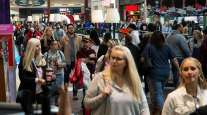It's Back to Steady for US Economy as Retail Sales, CPI Rise

Data released May 12 showed consumer retail purchases rose last month, albeit less than forecast, after a March gain that was revised from a decline, indicating the early-2017 slowdown was transitory.
The consumer-price index stabilized in April following the first drop in a year, though a gauge excluding food and energy posted the smallest year-over-year increase since October 2015.
Highlights of Recent U.S. Economic Data
• Retail sales increased 0.4% in April (forecast was 0.6% rise) after a 0.1% increase the prior month (revised from 0.2% decline).
• Consumer-price index rose 0.2% (matching forecast) in April after 0.3% drop in March. Excluding food and energy, prices were up 0.1%.
• University of Michigan preliminary index of consumer confidence rose to 97.7 in May (forecast was 97) from 97 in April.
The pickup in retail sales — with gains in nine of 13 major categories — eases concern from earlier in the year about a loss of momentum in household spending, the biggest part of the economy. The CPI results are a reminder that while businesses are regaining some pricing power, inflation is hardly breaking out.
Together, the data indicate progress consistent with the Federal Reserve’s view of the economy and inflation ahead of policymakers’ mid-June meeting, where they are widely expected to continue their gradual pace of interest-rate increases with a quarter-point hike. The Fed may feel less pressure, however, to pick up the pace should core inflation remain subdued.
“It’s a pretty decent overall picture of the U.S. economy,” said Sal Guatieri, a senior economist at BMO Capital Markets in Toronto. “Consumer spending is rebounding, though possibly not as much as we expected. On the inflation front, there’s not a lot of pricing pressure, and it looks like inflation is gravitating toward the Fed’s goal.”
A separate report showed that the University of Michigan consumer confidence index climbed to a four-month high in May, and within that, buying conditions for large household durables rose to the highest since 2005, reinforcing signs that Americans remain optimistic about spending.
“Today’s sub-consensus U.S. data is unlikely to rock the Fed’s boat, meaning there are increasingly few reasons for not hiking in June,” James Smith, an economist at ING in London, wrote in a note.
Consumer Demand
The details of the retail-sales report included some encouraging signs that a solid labor market is underpinning consumer demand, and that tax refunds that were delayed in early 2017 are beginning to make their way to Americans’ wallets, providing additional support in the months ahead. Sales rose at auto dealers and service stations along with electronics and appliance sellers, while Internet retailers, restaurants, sporting-goods stores and building-materials outlets also posted gains.
So-called control-group sales, which are used to calculate gross domestic product and exclude the categories of food services, auto dealers, building materials and gasoline stations, rose 0.2% after a 0.7% March gain that was the biggest since April 2016. Commerce Department data don’t reflect changes in prices.
On the inflation front, the news from the Labor Department was more mixed. While consumer prices climbed for shelter, energy, tobacco and food, costs declined for new and used vehicles, mobile-phone services, apparel and recreation. Medical care costs dropped 0.2%, the most since May 2013.
The CPI rose 2.2% from a year earlier, a tad below the forecast for a 2.3% gain and following a 2.4% increase in March. Core prices rose 0.1% from the prior month after falling 0.1%, and were up 1.9% from a year earlier.
One unusual factor in consumer prices: The tobacco index jumped 4.2%, its biggest gain in eight years, largely reflecting a $2 per-pack increase in California state taxes on cigarettes that went into effect on April 1. Without that boost, the core CPI would have been little changed, according to Omair Sharif, senior U.S. economist at Societe Generale.
Excluding the tobacco tax effect, the overall CPI index would have been up 0.1% in April instead of 0.2%, according to Steve Reed, an economist at the Labor Department.
The positive retail sales results confirm a strong rebound in second-quarter growth and the falling unemployment rate probably keeps a Fed rate hike likely for June, Ted Wieseman, an economist at Morgan Stanley, wrote in a note.
At the same time, Wieseman wrote that “core inflation is probably going to need to get back on track” in the coming months to support further tightening via interest rates or the balance sheet at Fed meetings followed by press conferences, which occur at alternating sessions.



